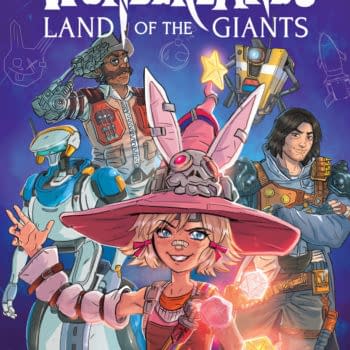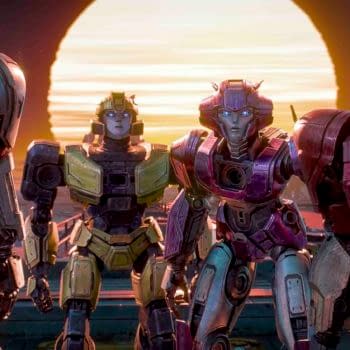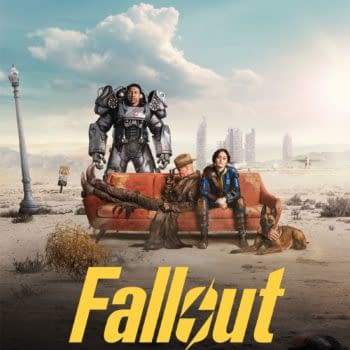Posted in: Look! It Moves! by Adi Tantimedh, Movies, TV | Tagged: anime, entertainment, japan, tokyo ghoul
It's A Hard Life For A Tokyo Ghoul – Look! It Moves! by Adi Tantimedh
Adi Tantimedh writes,
The summer anime season is coming to an end, and that includes season one of Tokyo Ghoul, a series that's been getting a certain amount of buzz, partly because it's one of the few horror series this season.
I wasn't planning to watch or write about Tokyo Ghoul, thought it was gratuitously hysterical and violent for my taste, but found myself following it anyway because I just had to see how deep it threw itself into that slimy rabbit hole and where that rabbit hole came from. After all, something that's popular and nasty has to hit the buttons of the people who like it, and I always want to find out why.
[youtube]https://www.youtube.com/watch?v=eNGhKIcHVQc[/youtube]
Adapted from the Seinen manga (aimed at older teen and college student boys), Tokyo Ghoul is about earnest college student Ken Kaneki who goes on a blind date with a woman that turns out to be a ghoul and attacks him. When a freak accident maims them both, a mysterious surgeon transplants her organs into his to save his life, and Kaneki finds himself craving human flesh and unable to eat any other food.
For a ghoul, meat is literally murder.
This is pulp anime existentialism.
Unable to continue to live in normal society, Kaneki falls into the underworld of ghouls that live in the shadows, form warring gangs and factions, feeding on humans and being hunted by The Doves, the police anti-ghoul division. Kaneki becomes increasingly anguished at his plight as a human-ghoul hybrid, reluctant to use his powers to harm anyone as he's drawn deeper and deeper into the sadistic war between ghouls and The Doves. Sooner or later, he's going to be forced to take a side.
Tokyo Ghoul is probably the most fucked up anime series of the year. It comes from a place of rage and despair. It's not that its melodramatic depictions of violence, sadism and persecution are new in manga and anime, it's that it takes that combination to a particularly hysterical level, full of R-rated levels of gory violence and torture that have to be censored for Japanese TV broadcast where a whole section of the screen has to be blacked out (but probably uncensored for the Blu-Ray and DVD). It's pure pulp, so there are thrown-in-a-blender metaphors for underclass persecution, class warfare, Japan's obsession with warfare, and power fantasies you find in superhero comics, only here the convention is inverted: the powers are horrific and grotesque extensions of their bodies.
[youtube]https://www.youtube.com/watch?v=7aMOurgDB-o[/youtube]
At the heart of the story is a tale of people who were abandoned and abused, leading to their alienation and violent natures. There's a lament, common in many manga and anime, for basic decency and empathy and the horrific results of the lack of same. There's a sense that the war between the human police and the ghouls is pointless and wouldn't have been necessary if everyone just got along. The ghouls, with their need to eat human flesh to survive, might be a metaphor for people forced to live a terrible, inescapable way of life. The series is relentlessly downbeat, a pall of doom and tragedy hanging over it. It's another expression of the lost generation of Japan that's been living under economic and social stagnation since the Bubble burst over 20 years ago. This is pulp anime existentialism.
The most interesting and insidious part of the series, to me, is the sense of repression at the heart of the story. I always thought the over-the-top superpowers in manga and anime were an expression of the repressed emotions and sense of powerlessness many Japan feel, and it's taken to an extreme degree in Tokyo Ghoul. Kaneki, the good-natured pacifist who wouldn't hurt a fly, is constantly attacked and tormented by his fellow ghouls who only come to accept him after he fights back and rips pieces off them. Touka, the angry ghoul girl who guides him often insults and berates him because it's obvious she likes him. There's a lof of sublimated sexual repression in the series, and the violence seems to be an expression of that. The powers the ghouls have are often phallic tentacles and blades that thrust out of their bodies to stab and pierce at enemies. It's all about dismemberments, impalements and spilling blood as opposed to other fluids. The Freudian imagery here is screaming out at us.
It's a typical expression of manga and anime where, not unlike US pop culture, violence seems okay, but any display of sex is a no-no. There is no overt expression of sexuality at all in Tokyo Ghoul. The pilot episode is nothing if not about the fear of female sexuality. Even the gay ghoul who's obsessed with Kaneki is a stereotype of a flamboyant, cultured, pretentious gay man (common in manga and anime, suggesting creators who probably never met a gay man in their lives) who expresses his attraction to Kaneki by saying how much he wants to eat him. Nobody ever kisses in an action-adventure manga or anime. That's reserved for series aimed at female audiences. You can find out a lot about a society's hang-ups by looking at their pop culture, and Japan's manga and anime are a treasure trove of not-so-hidden meanings.
The anime version of Tokyo Ghoul is actually more elegant in its pacing and storytelling than the manga is. Where the manga is often grotesque, the anime finds the line between beauty and horror, the body horror and transformations are almost reminiscent of the paintings of Francis Bacon. The animators also created some striking setpieces where colour and graphic design patterns are used to create an abstract headspace, as in the latter episodes where Kaneki retreats into his mind to face uncomfortable truths about his pacifist nature.
The first season ends on a cliffhanger: Kaneki has been tortured to the point of no return, and finally loses his attempt to hold onto his humanity and becomes a monster, the midpoint of the manga's story. The manga series ended just this month, so there's plenty of material for season two to draw on. However – SPOILER – the ending of the manga series leaves a lot of plot threads dangling with the hint of a sequel. Here in the West, the anime series has drummed up interest among fans to ask for an English translation of the manga. It'll be interesting to see if it gets picked up. It's not for the faint-of-heart or weak-of-stomach.
Tokyo Ghoul is now streaming on Hulu Plus and Funimation.
Eating vegetarians at lookitmoves@gmail.com
Follow the official LOOK! IT MOVES! twitter feed at http://twitter.com/lookitmoves for thoughts and snark on media and pop culture, stuff for future columns and stuff I may never spend a whole column writing about.
Look! It Moves! © Adisakdi Tantimedh

























